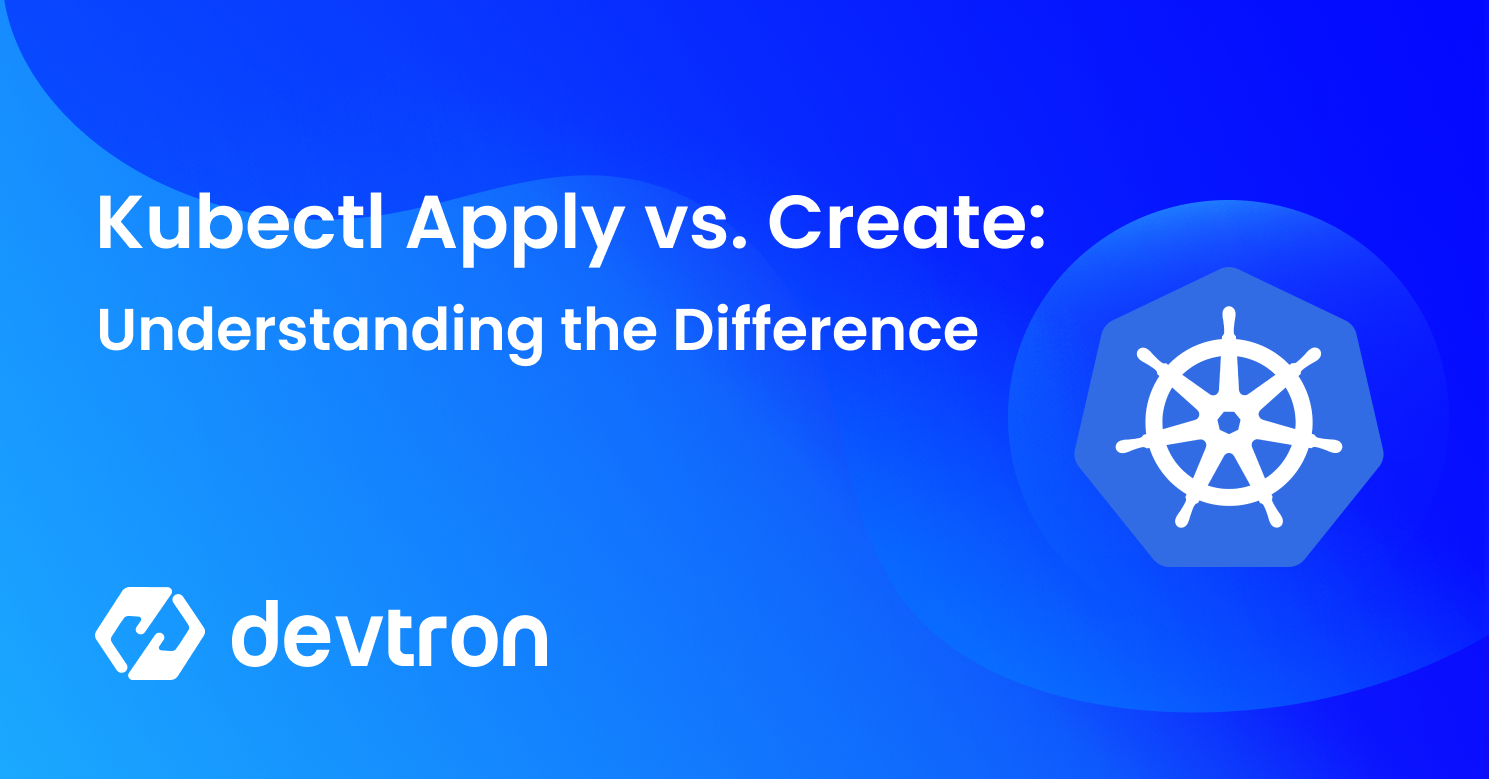kubectl apply vs create: Understanding the Differences
Learn the key differences between kubectl apply and kubectl create for managing Kubernetes resources effectively.
Learn the key differences between kubectl apply and kubectl create for managing Kubernetes resources effectively.
kubectl create and kubectl apply both create resources in Kubernetes, but they handle pre-existing resources differently. kubectl create creates a resource from a file or stdin. If a resource with the same name already exists, kubectl create throws an error. kubectl apply also creates or updates resources from a file or stdin. However, if the resource already exists, kubectl apply updates the existing resource with the configuration specified in the file. If a field is not defined in the file, kubectl apply will keep the existing value. In short, use kubectl create for initial resource creation. Use kubectl apply for subsequent updates, as it handles both creation and modification.
kubectl create and kubectl apply both create resources in Kubernetes, but they handle pre-existing resources differently.
kubectl create creates a resource from a file or stdin.
kubectl create -f deployment.yaml
If a resource with the same name already exists, kubectl create throws an error.
kubectl apply also creates or updates resources from a file or stdin.
kubectl apply -f deployment.yaml
However, if the resource already exists, kubectl apply updates the existing resource with the configuration specified in the file. If a field is not defined in the file, kubectl apply will keep the existing value.
In short, use kubectl create for initial resource creation. Use kubectl apply for subsequent updates, as it handles both creation and modification.
The code demonstrates the difference between kubectl create and kubectl apply commands. kubectl create creates a resource and throws an error if a resource with the same name already exists. kubectl apply on the other hand, creates a resource if it doesn't exist and updates it if it does, merging changes and preserving existing values.
deployment.yaml:
apiVersion: apps/v1
kind: Deployment
metadata:
name: nginx-deployment
spec:
replicas: 3
selector:
matchLabels:
app: nginx
template:
metadata:
labels:
app: nginx
spec:
containers:
- name: nginx
image: nginx:1.14.21. Create the deployment using kubectl create:
kubectl create -f deployment.yamlThis will create a deployment named "nginx-deployment" with 3 replicas.
2. Try creating the same deployment again:
kubectl create -f deployment.yamlThis will throw an error because a deployment with the same name already exists.
3. Update the deployment using kubectl apply to scale to 5 replicas:
updated-deployment.yaml:
apiVersion: apps/v1
kind: Deployment
metadata:
name: nginx-deployment
spec:
replicas: 5 kubectl apply -f updated-deployment.yamlThis will update the existing "nginx-deployment" to have 5 replicas. Notice that we didn't specify the selector or template fields in the updated file, but kubectl apply kept the existing values for those fields.
4. Try creating the deployment using kubectl apply:
kubectl apply -f deployment.yamlThis will not throw an error. Instead, it will report that the deployment was unchanged because the configuration in the file matches the existing deployment.
This example demonstrates how kubectl create is suitable for initial resource creation, while kubectl apply is more versatile for both creation and subsequent updates, as it merges changes and preserves existing values.
kubectl apply is idempotent, meaning you can run the same command multiple times without changing the final state of the resource. kubectl create, however, will throw an error if you try to create an already existing resource. This makes kubectl apply more suitable for automation and CI/CD pipelines.kubectl create is more of an imperative command - you tell Kubernetes to create a specific resource. kubectl apply follows a declarative approach - you describe the desired state of the resource, and Kubernetes figures out how to achieve it.kubectl apply uses a server-side mechanism to track changes made to resources. This allows for better change tracking and rollback capabilities compared to kubectl create.kubectl create: Best for initial resource creation when you are sure the resource doesn't already exist.kubectl apply: Ideal for managing resource configuration throughout their lifecycle, especially in automated environments. Use it for updates, modifications, and even initial creation if you are unsure about the resource's existence.kubectl replace and kubectl patch offer more granular control over resource updates. However, kubectl apply is generally preferred for its ease of use and robust features.In summary:
kubectl create might suffice.kubectl apply is the recommended approach due to its idempotency, declarative nature, and change tracking capabilities.| Feature | kubectl create |
kubectl apply |
|---|---|---|
| Action | Creates resources | Creates or updates resources |
| Handling Existing Resources | Throws an error if a resource with the same name exists | Updates the existing resource with the provided configuration |
| Updating Resources | Not applicable | Updates existing fields and preserves values for unspecified fields |
| Ideal Use Case | Initial resource creation | Subsequent updates and modifications |
In essence:
kubectl create for the initial setup of your resources.kubectl apply for ongoing management and updates, leveraging its ability to handle both creation and modification seamlessly.Choosing between kubectl create and kubectl apply depends on your use case. While kubectl create is suitable for initial resource creation, kubectl apply offers a more robust and flexible approach for managing Kubernetes resources throughout their lifecycle. Its ability to handle both creation and updates, along with its idempotent nature and change tracking mechanisms, makes it the preferred choice for modern, automated Kubernetes workflows.
 Kubectl apply vs. create: What's the difference? | TheServerSide | Many Kubernetes commands have overlapping function. Learn the difference between kubectl apply vs. create commands and when to use them.
Kubectl apply vs. create: What's the difference? | TheServerSide | Many Kubernetes commands have overlapping function. Learn the difference between kubectl apply vs. create commands and when to use them. kubectl create vs kubectl apply. What's the difference? | by Emma ... | When it comes to creating an object (a pod, a deployment, a service, and so on) in a Kubernetes cluster, the most common way is to define a…
kubectl create vs kubectl apply. What's the difference? | by Emma ... | When it comes to creating an object (a pod, a deployment, a service, and so on) in a Kubernetes cluster, the most common way is to define a… Kubectl Apply Vs Create - Startup House | Startup House | Manage Kubernetes resources efficiently with kubectl. Use kubectl apply for declarative config management, partial updates.
Kubectl Apply Vs Create - Startup House | Startup House | Manage Kubernetes resources efficiently with kubectl. Use kubectl apply for declarative config management, partial updates. kubectl apply: Syntax, Examples, kubectl apply vs. create/replace | The ‘kubectl apply’ command is a declarative way of deploying resources on a cluster using YAML manifest files. It applies a configuration to a resource by file name or stdin. The resource name must be specified. If the resource doesn't exist yet, it will be created.
kubectl apply: Syntax, Examples, kubectl apply vs. create/replace | The ‘kubectl apply’ command is a declarative way of deploying resources on a cluster using YAML manifest files. It applies a configuration to a resource by file name or stdin. The resource name must be specified. If the resource doesn't exist yet, it will be created. Difference Between kubectl apply and kubectl create | Baeldung on ... | Learn how the kubectl object management works with kubectl create and kubectl apply.
Difference Between kubectl apply and kubectl create | Baeldung on ... | Learn how the kubectl object management works with kubectl create and kubectl apply. Kubectl Apply vs. KubeCtl Create: Kubernetes for beginners | TL;DR: kubectl create creates new Kubernetes resources, while kubectl apply updates existing resources based on configuration files. Learn how each handles configuration changes and when to use them for managing Kubernetes resources.
Kubectl Apply vs. KubeCtl Create: Kubernetes for beginners | TL;DR: kubectl create creates new Kubernetes resources, while kubectl apply updates existing resources based on configuration files. Learn how each handles configuration changes and when to use them for managing Kubernetes resources.